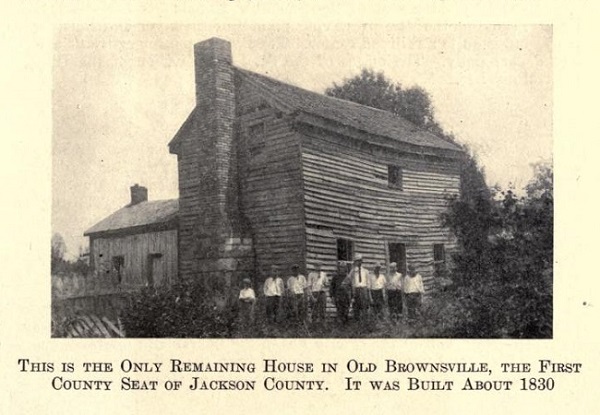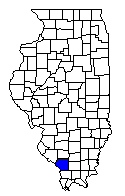
SETTLED EARLY PART NINETEENTH CENTURY - SALT INDUSTRIES POUNDED -
ILLINOIS CENTRAL BRINGS SETTLERS - CARBONDALE PLATTED - COAL MINING - GRAND
TOWER - MURPHYSBORO.
When Jackson county was created by act of the general assembly, January 10,
1816, it included just what it does today, except a strip several miles wide
was cut off of the north side to add to Perry when that county was created
in 1827. This county has the Mississippi for a boundary on the west some
eighteen miles, and the Big Muddy river passes through it from northeast to
southwest. The tributaries to these two rivers are themselves good sized
creeks, so the county is well watered. The south side is in the region of
the Ozarks and is very hilly, but the central and north side are slightly
rolling. There are large areas of submerged lands along the Mississippi
bottoms. The county is underlaid with a very fine quality of coal and the
quantity is in abundance. There have been excellent forests, but many of
them have disappeared before the onward march of the farmer and the hard
lumber man.
SETTLED EARLY PART OP NINETEENTH CENTURY
Prior to 1800 there were no whites permanently settled in the limits of the
present county. An old historian says the first whites crossed into Jackson
county over Degognia Creek, the boundary on the northwest, to make maple
sugar in the northwestern part of the county. Two men and their families, a
Mr. Reed, and Emsly Jones, settled in the county in 1802. Jones killed Reed
and was hanged in Kaskaskia. In 1805 or 1806, Wm. Boone moved from near
Kaskaskia to the northwestern part of the county and settled near Degognia
Creek. A family by the name of Brooks came they were friends of Boone.
As early as 1804 Henry Noble and Jesse Griggs settled on Big Muddy above
where Murphysboro now stands. Others settled near, one a tailor, another a
miller. The settlers began to arrive and by the war of 1812 there were
enough people in the region of the Big Muddy to constitute a company of
Rangers. Such a company was commanded by Capt. William Boone. There were 80
men and officers. The "big hill" near Grand Tower and the "devil's oven"
were settled as early as 1807. William Boone moved from the northwest corner
of the county to what was called the "Sand Ridge," just where Kinkaid Creek
flows into Big Muddy, in 1806-7. Here the government had set aside a
reservation for the Kaskaskia Indians and at that time there were about
sixty camps or lodges on the reservation. A few settlers had cabins on the
Big Muddy near the Williamson county line. Here they built a block house as
early as 1811.
SALT INDUSTRIES FOUNDED

About 1813 Dr. Conrad Will came to this county. He discovered salt
springs on the Big Muddy in 1814. He bought kettles in Pittsburgh and began
the manufacture of salt in 1814 or 1815. Around these salt works grew up Old
Brownsville, which was made the county seat in 1816. This remained the seat
of justice till 1843, when the county seat was moved to Murphysboro. The
site of Murphysboro had previously been settled by Dr. John Logan, father of
Gen. John A. Logan. Conrad Will managed the salt works, owned a store, ran a
tan yard, and practiced medicine, served in the legislature and assisted in
the management of county affairs. Alexander Jenkins, a young man of promise,
was a protege of Dr. Conrad Will. Wm. Boone built a flat boat at the mouth
of Kinkaid Creek and made a trip to New Orleans in 1811. In 1814 the Duncans
settled at the Big Hill, and the father, Joseph Duncan, built the finest
house in the county. It stood near the river and just at the northwest
corner of the Big Hill. It was called the "White House."
ILLINOIS CENTRAL BRINGS SETTLERS

The eastern half of the county was not settled till late in the first
half of the 19th century. The Illinois Central was finished in 1854. This
brought many settlers, and towns sprang up. The early history is therefore
confined to the section along the Big Muddy and the northwest which was
close to Kaskaskia. Marcus Green Reynolds, now living a few miles south of
Murphysboro, came to that region in 1832. He was from the Carolinas.
Governor Barteme Reynolds, the first Royal governor of Georgia, was an
ancestor of Mr. Marcus G. Reynolds. He came to this county when Indians were
still on their reservation on the Sand Ridge. He remembers Alexander
Jenkins, Conrad Will, Dr. Roberts, Peter Kimmel, Rev. Nail, Dr. John Logan,
and other early settlers in or near Brownsville. He remembers the first
steam mill in the county. He gives this recipe for the ink made in the early
schools: Maple bark, copperas, indigo, sugar. Old Brownsville, he thinks,
was a town of three or four hundred people; there was a bank, stores, hotel,
tan yard, salt works, jail, and court house used for school and church
purposes. Here is where Gen. John A. Logan went to school in the court
house.
Another old settler still living is Wm. Green Williams. He came in 1832. He
knew most of the people whom Mr. Reynolds knew. He was often in Old
Brownsville and remembers well the removal of the county seat from
Brownsville to Murphysboro in 1843. He now lives northwest of Carbondale two
or three miles.
CARBONDALE PLATTED
In 1852, the town of Carbondale was laid off on the newly built railroad the
Illinois Central. The town was laid off by several men who were interested
in the new venture. Among them were John Dougherty, Col. D. H. Brush, Asgill
Connor, A. Buck, L. W. Ashley, J. P. Ashley, Wm. Richart and others. A
clause in the original deeds to lots prohibited the sale of intoxicating
liquors on any lot in Carbondale, but in after years the lawyers got their
heads together and decided the restriction would not hold in the courts, and
saloons were installed for a period of ten years, but for the past four
years there have been no legalized saloons in the city.
Carbondale is the seat of the Southern Illinois State Normal University,
contains the "tie preserving plant" of the Ayer and Lord company, and is
quite a railroad center. Twenty-five passenger trains arrive and depart
daily. The offices of the St. Louis division of the Illinois Central are
here.
COAL MINING
In a very early day, probably as early as 1830, coal was discovered on the
Big Muddy. Large quantities were sent out of the Big Muddy on flat boats and
barges. Coal has been a source of great revenue to this county, and is
responsible for considerable railroad building. The quality and quantity, as
has been said, is marked. Jackson and Williamson constitute the Tenth
District under the mining laws of the state, and Jackson ranks 19th in
production, putting out 621,853 tons in 1910. The report for 1911 shows 26
mines for this county, employing 1,184 men, 17 of them are what are called
local mines.
Jackson was originally well timbered, but much of the better grades has been
shipped out and only the second and third rate grades are left. The south
half of the county lies in the Ozarks and immense quantities of fruits and
vegetables are shipped from the railroad points. Pine rock quarries are to
be found in this county at Grand Tower and at Bosky Dell.
GRAND TOWER
Grand Tower on the Mississippi is an interesting river town. In about the
year 1885 a railroad was built from Carbondale to Grand Tower. This
connected with the Illinois Central at Carbondale, tapped the coal fields at
Murphysboro and passed through the best timbered regions of the county.
There were two iron furnaces at Grand Tower and extensive coke ovens at
Murphysboro. The furnaces were abandoned about 1892 or earlier and the town
suffered in consequence. Large rock quarries have been in operation in Grand
Tower. The town had a population of 875 in 1910. The northwestern part of
the county has two towns, Ava and Campbell Hill. Along the line of the
Illinois Central, passing through Carbondale from south to north, are the
towns of Makanda, a fruit shipping point, Bosky Dell, the site of extensive
quarries, DeSoto and Elkville - coal stations and country towns.
MURPHYSBORO
Murphysboro, the county seat, is a city of over 7,000 people. It has several
coal mines, the shops of the Mobile and Ohio railroad, and an extensive
trade in groceries, dry goods, farm supplies, and lumber. There are five
banks, an extensive shoe factory, foundries, and a paving brick plant that
makes a very fine grade of paving blocks. The professions are fully
represented. Here was the birthplace of Gen. John A. Logan and here some of
his near kin live today. Murphysboro has many churches and the school
interests are represented by an elegant township high school.
Extracted from 1912 A History of Southern Illinois, by George W. Smith, volume 1, page 481.
Randolph |
Perry | Franklin |
Perry MO |
 |
Williamson |
| Union |


